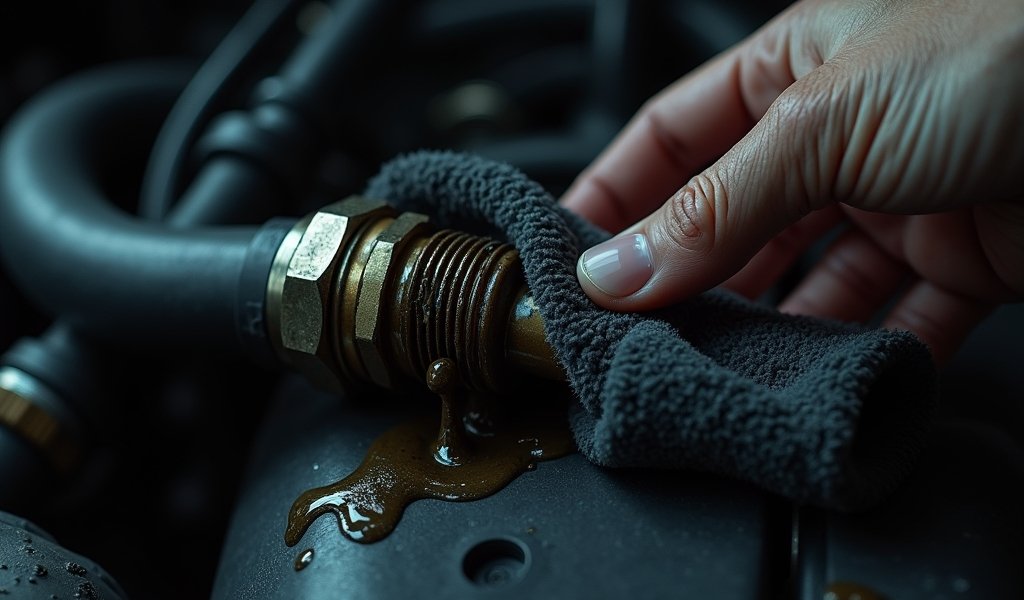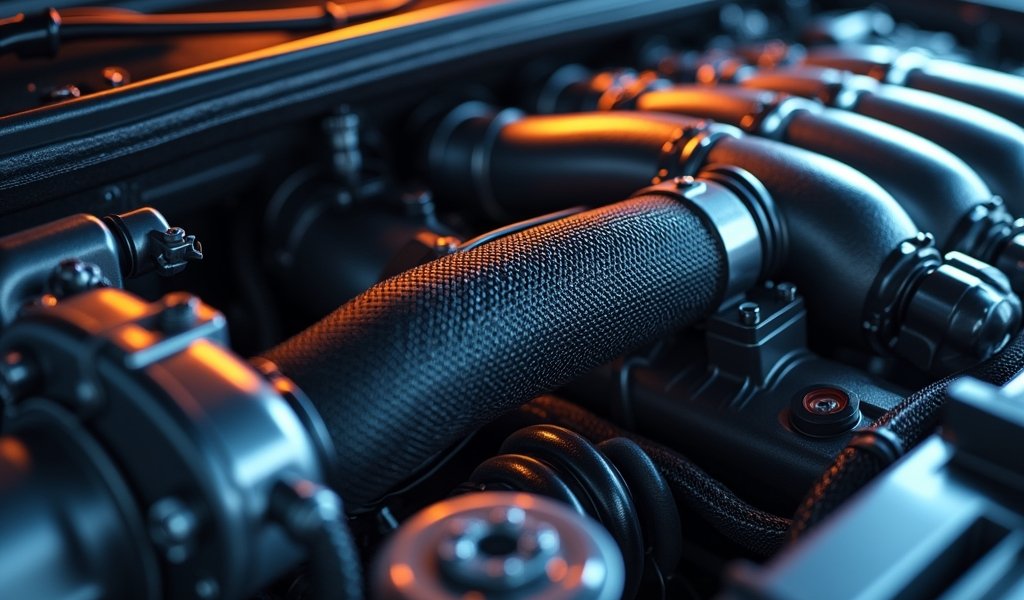Overview
This article outlines five effective solutions for oil cooler line connection problems: proper tightening techniques, replacing worn gaskets, using thread sealants, complete line replacement, and upgrading to quick-connect systems. It emphasizes the importance of regular maintenance to prevent leaks and engine damage, providing specific guidance on identifying problems, implementing fixes, and choosing between DIY repairs and professional help.
Table of Contents
- Understanding Oil Cooler Lines
- Signs of Oil Cooler Line Connection Problems
- Fix #1: Proper Tightening Techniques
- Fix #2: Replacing Worn Gaskets and O-rings
- Fix #3: Using Thread Sealants and Adapters
- Fix #4: Complete Line Replacement
- Fix #5: Upgrading to Quick-Connect Systems
- Preventative Maintenance
- Conclusion
- Frequently Asked Questions
Understanding Oil Cooler Lines
Ever looked under your car and spotted that dreaded dark puddle? If you’re nodding, you might be dealing with oil cooler line connection issues. These unassuming components play a crucial role in your vehicle’s health, acting as the arteries of your engine’s circulatory system.
Oil cooler lines transport hot oil from your engine to the cooler where it’s brought down to a manageable temperature before returning to lubricate your engine components. Without properly functioning cooler lines, your engine could be one short drive away from overheating or suffering severe damage.
As a mechanic who’s seen countless engines saved (and sadly, some lost) due to oil cooler issues, I can’t stress enough how important these humble hoses are. Think of them as the unsung heroes of your engine bay – they rarely get attention until something goes wrong.
Signs of Oil Cooler Line Connection Problems
Your vehicle has its own way of crying for help when oil cooler connections start failing. The most obvious sign is oil spots under your vehicle after it’s been parked. It’s like your car’s way of saying, “Hey, we have a problem here!”
That distinctive burning oil smell while driving is another red flag. If you catch a whiff that reminds you of a busy repair shop, pay attention – your nose is telling you something’s not right.
Watch your dashboard too. A dropping oil pressure gauge or illuminated oil warning light shouldn’t be ignored. These indicators are your vehicle’s last-ditch effort to prevent catastrophic damage.
Engine overheating can also signal oil cooler line issues, as proper oil circulation is vital for temperature regulation. If your temperature gauge starts climbing into the danger zone, especially during highway driving or towing, your cooling system routing might be compromised.

Fix #1: Proper Tightening Techniques
The most common culprit behind leaky oil cooler connections is improper tightening. It’s a bit like Goldilocks – not too tight, not too loose, but just right. Over-tightening can be just as problematic as under-tightening, causing damaged threads or crushed gaskets.
To identify loose connections, start with a clean engine. Wipe down the connection points, run the engine briefly, then check for fresh oil around fittings. Any movement when gently testing the lines indicates attention is needed.
The Right Way to Tighten
- Always consult your vehicle’s service manual for exact torque specifications
- For most passenger vehicles, oil cooler fittings typically require 10-25 ft-lbs
- Use a quality torque wrench rather than muscling it with a standard wrench
- Thread fittings by hand first to prevent cross-threading
Essential tools for this job include a torque wrench (beam type or click type), appropriately sized wrenches, clean rags, and safety glasses (because oil in the eye is something you’ll only experience once before becoming religious about eye protection).
When tightening connections, ensure the engine is cool and pressure is relieved. Apply a light coating of clean motor oil to threads if recommended by your manufacturer. After tightening to spec, run the engine and check for leaks, then recheck torque after the first heat cycle. This methodical approach, as recommended by professional technician resources, prevents most common oil cooler line issues.
Fix #2: Replacing Worn Gaskets and O-rings
Sometimes, no amount of tightening will fix a leaking connection because the real villains are worn gaskets or O-rings. These humble rubber and metal components may be small, but they’re mighty important in keeping your oil where it belongs.
You’ll know you’re dealing with gasket or O-ring failure when leaks persist despite proper torque, or you notice visible damage, deformation, or hardening of the seals. Oil weeping even after tightening is another telltale sign that your seals have given up the ghost.
Choosing the Right Materials
- Copper washers work well for metal-to-metal connections and can sometimes be reused
- Aluminum crush washers are single-use only – always replace them
- For high-temperature applications, fluoroelastomer O-rings offer superior heat resistance
- Never use silicone O-rings in oil systems as they degrade quickly in that environment
When replacing these components, cleanliness is crucial. Carefully remove old gaskets without scratching sealing surfaces. Compare new parts with old ones to ensure correct sizing. A small dab of clean oil on new gaskets makes installation easier and helps create a better seal.
If you’re dealing with persistent oil leak issues even after replacing seals, you might need to look deeper into the system. Sometimes, what appears as a simple gasket problem might signal a more complex issue with the cooler itself.
Fix #3: Using Thread Sealants and Adapters
When physical connections need a little help, thread sealants come to the rescue. Think of them as the peacekeepers between metal surfaces that just don’t want to get along.
Thread sealants are ideal for tapered pipe thread connections (NPT), but should generally be avoided on flare or compression fittings. They’re particularly useful for older connections or where slight thread damage has occurred.
Choosing the Right Sealant
- PTFE tape: The white tape we all know, but did you know there’s a yellow version specifically designed for oil systems?
- Liquid thread sealers: Products like Permatex® Thread Sealant offer excellent properties with controlled strength
- Anaerobic sealants: These harden in the absence of air and create very strong seals
When applying sealants, less is more. Clean threads thoroughly before application. For PTFE tape, wrap in the direction of the threads (usually clockwise) to prevent unwrapping during installation. Allow proper curing time for liquid sealants before pressurizing the system.
Adapters can be lifesavers when dealing with problematic connections. Options include AN to NPT adapters for converting between standards, reducer/expander adapters for size mismatches, and repair adapters designed to remedy damaged connection points. Just remember that each additional connection is another potential leak point, so use adapters judiciously.
According to the Society of Automotive Engineers standards, proper thread engagement and sealant selection can make the difference between a leak-free connection and ongoing problems.

Fix #4: Complete Line Replacement
Sometimes, the best fix isn’t a fix at all – it’s a fresh start. When your oil cooler lines have multiple leak points, visible corrosion, or hardened rubber sections, it’s time for a complete replacement. Think of it as giving your engine a new set of arteries.
You should consider full replacement after any significant engine overhaul or preventatively at high mileage (typically 100,000+ miles). It’s cheaper to replace lines on your schedule than to have them fail on theirs – usually at the most inconvenient time possible.
OEM vs. Aftermarket
This is where you’ll face the eternal automotive dilemma: original equipment manufacturer (OEM) parts offer perfect fitment but often at premium prices. Quality aftermarket options can provide 80-90% of the quality at 50-60% of the cost.
For daily drivers, quality aftermarket lines are usually sufficient, while restoration projects or high-performance applications might justify the OEM investment. I’ve installed hundreds of both, and for most vehicles, a quality aftermarket line from brands like Dorman will serve you well for years.
Material Choices:
- Rubber lines: Economical but shorter lifespan (30,000-60,000 miles)
- Steel braided lines: Superior durability and heat resistance
- Stainless steel: Maximum longevity but highest cost
- Copper-nickel tubing: Excellent corrosion resistance and easier to shape
During installation, document the original routing with photos before removal. This simple step has saved me countless headaches when trying to remember exactly how things were positioned. Start reconnection from the hardest-to-reach connection, and always route lines away from exhaust components and moving parts.
If you’re comfortable with basic automotive line work, this is a DIY-friendly job that can save you significant labor costs. Just take your time and be methodical about keeping track of parts and connections.
Fix #5: Upgrading to Quick-Connect Systems
For those looking to embrace newer technology, quick-connect systems represent the cutting edge in fluid transfer connections. These modern marvels offer reliability with convenience, making future maintenance significantly easier.
The benefits are substantial: toolless connections save installation time, reduced thread interfaces mean fewer potential leak points, and positive locking mechanisms prevent accidental disconnection. Internal O-rings provide superior sealing compared to traditional methods.
Vehicle Compatibility
Quick-connect systems are widely available for domestic vehicles, particularly Ford, GM, and Chrysler models from 2000 onwards. European applications are increasingly common, though older or exotic vehicles may require custom adapter solutions.
Installation is straightforward: select the appropriate kit for your vehicle, remove existing lines, install any necessary adapter fittings, and insert the lines into the quick-connect fittings until you feel the positive click. Always test by gently pulling back – the connection should resist separation.
One of the joys of quick-connect systems is their minimal maintenance requirements. However, you should inspect visible O-rings annually for wear and keep protective caps on unused connections. Avoid using excessive force when connecting or disconnecting – these systems are designed to work with moderate hand pressure.
Preventative Maintenance
As we say in the shop, “An ounce of prevention saves a gallon of oil on your driveway.” Regular maintenance can extend the life of your oil cooler lines significantly and save you from roadside disappointments.
Develop a regular inspection schedule: visual checks during every oil change, physical inspection with gentle testing of connections every 15,000 miles, and full system pressure tests annually for vehicles over 5 years old. Add additional checks after any underbody impact or service.
Cleaning and Care
Engine grime can hide small leaks and accelerate deterioration of rubber components. A gentle degreasing of the oil cooler and lines every 30,000 miles can extend their service life significantly. Use only automotive-safe degreasers and avoid high-pressure washing directly at the connections.
Temperature extremes are the enemy of oil cooler components. Parking in direct sun during hot summer days or making short trips in freezing weather can accelerate aging. When possible, garage your vehicle or use engine block heaters in extreme cold to reduce thermal stress.
Premium oil and regular changes are your oil cooler’s best friends. Contaminants in old oil can erode seals from the inside and create sludge that impedes cooling efficiency. As noted in machinery lubrication research, clean oil dramatically extends the life of cooling components.
Conclusion
Oil cooler line connections might seem like minor components in your vehicle’s complex systems, but their failure can have major consequences. The five fixes we’ve explored—proper tightening techniques, replacing worn gaskets, using thread sealants, complete line replacement, and upgrading to quick-connect systems—provide a comprehensive toolkit for addressing virtually any oil cooler line connection issue.
Cost considerations vary widely depending on your approach. DIY gasket replacement might cost just $10-20 in parts, while a complete professional replacement with OEM parts could run $300-500. The good news? Even the most expensive preventative maintenance is far cheaper than the engine damage that can result from neglect.
While many of these fixes are within reach of a moderately skilled DIYer, don’t hesitate to seek professional help if you’re uncomfortable working with your vehicle’s oil system. Remember, your vehicle’s oil cooler system isn’t just about preventing leaks—it’s about ensuring the long-term health of your engine. By maintaining these critical connections, you’re making an investment in your vehicle’s longevity and your own peace of mind.
After all, the road ahead looks much brighter when you’re not leaving a trail of oil behind you.
Frequently Asked Questions
How do I know if my oil cooler lines are leaking?
Look for oil puddles under your parked vehicle or dark stains around connection points. You might also notice a burning oil smell, dropping oil pressure, or engine overheating during operation.
Can I drive with leaking oil cooler lines?
It’s not recommended as you risk engine damage from low oil levels or overheating. Short drives to a repair facility might be acceptable if you monitor oil levels carefully and refill as needed.
How much does it cost to replace oil cooler lines?
DIY replacement costs typically range from $30-$150 for parts depending on your vehicle and material choice. Professional replacement including labor usually runs $200-$500 depending on vehicle complexity and location.
How long do oil cooler lines typically last?
Rubber lines generally last 5-7 years or 50,000-70,000 miles. Metal lines can last the lifetime of the vehicle unless damaged by corrosion, impact, or excessive vibration.
Can I use JB Weld or similar epoxy to fix leaking oil cooler lines?
Epoxy products like JB Weld should only be used as emergency, temporary repairs. They cannot withstand the pressure and temperature cycling of oil cooler systems long-term and will eventually fail.

